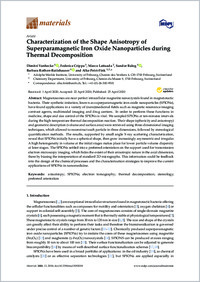Characterization of the shape anisotropy of superparamagnetic iron oxide nanoparticles during thermal decomposition
- Vanhecke, Dimitri Adolphe Merkle Institute, University of Fribourg, Chemin des Verdiers 4, CH-1700 Fribourg, Switzerland
- Crippa, Federica Adolphe Merkle Institute, University of Fribourg, Chemin des Verdiers 4, CH-1700 Fribourg, Switzerland
- Lattuada, Marco Chemistry Department, University of Fribourg, Chemin du Musée 9, 1700 Fribourg, Switzerland
- Balog, Sandor Adolphe Merkle Institute, University of Fribourg, Chemin des Verdiers 4, CH-1700 Fribourg, Switzerland
- Rothen-Rutishauser, Barbara Adolphe Merkle Institute, University of Fribourg, Chemin des Verdiers 4, CH-1700 Fribourg, Switzerland
- Petri-Fink, Alke Adolphe Merkle Institute, University of Fribourg, Chemin des Verdiers 4, CH-1700 Fribourg, Switzerland - Chemistry Department, University of Fribourg, Chemin du Musée 9, 1700 Fribourg, Switzerland
-
2020
Published in:
- Materials. - 2020, vol. 13, no. 9, p. 2018
English
Magnetosomes are near-perfect intracellular magnetite nanocrystals found in magnetotactic bacteria. Their synthetic imitation, known as superparamagnetic iron oxide nanoparticles (SPIONs), have found applications in a variety of (nano)medicinal fields such as magnetic resonance imaging contrast agents, multimodal imaging and drug carriers. In order to perform these functions in medicine, shape and size control of the SPIONs is vital. We sampled SPIONs at ten-minutes intervals during the high- temperature thermal decomposition reaction. Their shape (sphericity and anisotropy) and geometric description (volume and surface area) were retrieved using three- dimensional imaging techniques, which allowed to reconstruct each particle in three dimensions, followed by stereological quantification methods. The results, supported by small angle X-ray scattering characterization, reveal that SPIONs initially have a spherical shape, then grow increasingly asymmetric and irregular. A high heterogeneity in volume at the initial stages makes place for lower particle volume dispersity at later stages. The SPIONs settled into a preferred orientation on the support used for transmission electron microscopy imaging, which hides the extent of their anisotropic nature in the axial dimension, there by biasing the interpretation of standard 2D micrographs. This information could be feedback into the design of the chemical processes and the characterization strategies to improve the current applications of SPIONs in nanomedicine
- Faculty
- Faculté des sciences et de médecine
- Department
- Département de Chimie, AMI - Bio-Nanomatériaux
- Language
-
- English
- Classification
- Chemistry
- License
-
License undefined
- Identifiers
-
- RERO DOC 328601
- DOI 10.3390/ma13092018
- Persistent URL
- https://folia.unifr.ch/unifr/documents/308701
Statistics
Document views: 138
File downloads:
- pdf: 219
